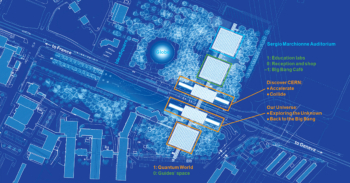Ken Peach argues that particle physicists can lead the way in a paradigm shift in scientific publishing to give everyone free access to research results.
There is a quiet revolution under way in academic publishing that will change how we publish and access scientific knowledge. “Open access”, made possible by new electronic tools, will give enormous benefits to all readers by providing free access to research results.

The scientific articles published in journals under the traditional publishing paradigm are paid for through subscriptions by libraries and individuals, creating barriers for those unable to pay. The ever-increasing cost of the traditional publishing methods means that many libraries in Europe and the US – even the CERN Library, which is supposed to serve international researchers at a centre of excellence – are unable to offer complete coverage of their core subjects.
In 2003 the Berlin Declaration on open access to knowledge in the sciences and the humanities was launched at a meeting organized by the Max Planck Society. Six months later, the first practical actions towards implementing the recommendations of the declaration on an international level were formulated at a meeting held at CERN in May 2004. So far the declaration has been signed by 61 organizations throughout the world, which are now taking concrete measures for its implementation.
An obvious prerequisite for open access is that institutions implement a policy requiring their researchers to deposit a copy of all their published works in an open-access repository. The Council for the Central Laboratory of the Research Councils’ library committee in the UK sponsored such a project, ePubs, with the aim of achieving an archive of the scientific output of CCLRC in the form of journal articles, conference papers, technical reports, e-prints, theses and books, containing the full text where possible.
The feasibility study, carried out from January to March 2003, demonstrated the business need for this service within the organization. The data, going back to the mid-1960s, can be retrieved using the search interface or the many browse indices, which include year, author and journal title. In addition the ePubs system is today indexed by Google and Google Scholar. The scientific content of the system has further led Thomson ISI (the provider of information resources including Web of Knowledge and Science Citation Index) to classify ePubs as a high-quality resource.
The next step is to encourage the researchers – while of course fully respecting their academic freedom – to publish their research articles in open-access journals where a suitable journal exists.
In recent years new journals applying alternative publishing models have appeared in the arena. The problem so far is that none of these journals have a long-term business model. They are sponsored either by a research organization or by other titles in the publisher’s portfolio, or enjoy sponsorship that will not last forever.
Scientific publishing has a price and will continue to have a price, currently mainly covered by academic libraries through subscriptions. Moving to an open-access publishing model should dramatically reduce the global cost for the whole of the academic community. The publication costs should be considered a part of the research cost and the research administrators should budget for these when the research budgets are allocated. However, a change must not take place without safeguarding the peer-review system, which is the guarantor of scientific quality and integrity.
Outside biology and medicine, few journals that support open access are given the same academic credits as the traditional journals. This situation is further reinforced if there is a direct coupling between research funding and the “impact factors” of journals where results are published. However, by taking the risk and publishing important work in new journals that implement the open-access paradigm, the impact factor will automatically be enhanced.
The example of the Journal of High Energy Physics (JHEP) is striking. This relatively new journal was launched by the International School for Advanced Studies (SISSA) in Trieste in 1997. Today some studies give it an impact factor close to that of Physical Review Letters in publishing papers on high-energy physics. JHEP was launched ahead of its time and was forced, because of the lack of financial support, to become a subscription journal. However, with the support of the main physics laboratories, it would be possible in the present climate for this successful journal to enter the open-access arena once again.
If a change is wanted, it is up to us. Particle physics cannot change the world alone, but a clear position among our authors and our members of editorial boards will have a strong synergy with our colleagues pulling in the same direction in other fields.





